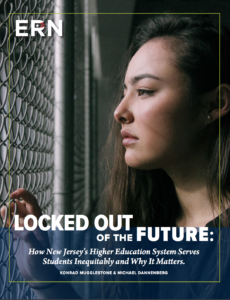Locked Out of the Future
Education policy and equity folks nationally and almost everyone in New Jersey are aware of the state’s storied school finance litigation history. But in all likelihood, comparably few know just how inequitable and inadequate education opportunity and success are at the higher education level as well.
K-12 school finance equity and education reform efforts are going to fail and economic inequality is going to worsen, if the nation and New Jersey do not comprehensively and successfully tackle our higher education equity challenge.
Here’s what we found in our deep dive analysis of New Jersey higher education:
- New Jersey’s K-16 education system is not meeting business and workforce needs.
- For projected new jobs, only two states have a greater demand for bachelor’s degrees or higher attainment. (Washington, D.C., & Massachusetts)
- New Jersey’s white population earns bachelor’s degrees at a rate needed to keep up with job demand (43%), but Black and Latinx degree attainment rates (23% & 17%) lag far behind.
- New Jersey students of color effectively are funneled into two-year county colleges that have extremely low completion rates.
- A New Jersey Black student is nearly 30% less likely to enroll in an in-state public four-year college than his/her White peer. A Latinx student is 18% less likely.
- Nearly half of New Jersey Black and Latinx college students attend public two-year institutions, where all things being equal, their likelihood of completion is 30 percentage points less than similar students with similar academic credentials attending four-year schools.
- Over 85% of first-time, full-time Black and Latinx two-year New Jersey county college students leave school without a degree – often with student loan debt to boot.
- There are gross inequities in state higher education aid funding decisions with little policy rationale.
- Rowan University serves a statistically less needy student body than Montclair State (30.5% vs. 46.2% Pell Grant-eligible), but is awarded three times more in state general operating aid per student than Montclair State ($7,146 v. $2,359 per pupil).
- The average New Jersey Tuition Assistance Grant (TAG) funding per student is $8,626 at private, non-profit colleges and only $1,762 at public county colleges. For students from the lowest family income households, only three states have a higher after financial aid total net cost of attendance than New Jersey.
- Princeton University receives $1 million in TAG funding despite a $27 billion endowment and institution guarantee to meet full economic need of low and middle-income students with university grant aid.
- New Jersey has unacceptably large degree completion gaps among racial subgroups.
- While completion rates at New Jersey four-year public colleges are higher than the national average for most groups, there are also larger than average completion gaps among racial subgroups. New Jersey has the 8th largest Latinx-White degree completion gap in the nation. New Jersey’s first-time, full-time Black community college students are less than half as likely as their White peers to finish a 2-year degree within 3 years of initial enrollment.
- Even when compared to similar colleges serving similar students, New Jersey colleges underserve racial subgroups and underperform. Stockton University and SUNY New Paltz serve a similar percentage of Pell Grant students (35.1% v. 33.2%) and have a similar median SAT score (1074 v. 1124), yet whereas SUNY New Paltz graduates 69.2% of Black students, Stockton only graduates 35.7% within six years of initial enrollment.
In order to assist New Jersey policymakers and advocates in addressing these challenges, we provide an in-depth overview of enrollment need and patterns; examine inequities in college preparation, affordability, and completion; and analyze existing state spending for institutions and programs designed to make college more affordable.
Going forward, to the extent the Governor’s forthcoming higher education proposals address the issues we raise in our latest issue brief, we’ll provide comment and further recommendations for improvement. Our main purpose with this latest issue brief is to identify the state’s multi-faceted “to and through” college challenge and set the stage for future policy recommendations.
Here’s hoping New Jersey is up to the challenge.

Read our New Report Here
Press Release Here
# # #